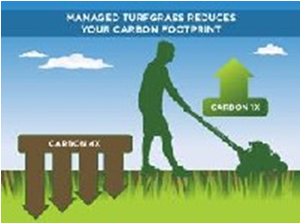Real turf vs Synthetic turf
The following information was sourced from “The Lawn Institute”. A good reason to have real turf in lieu of imitation synthetic turf.
Responsibly Managed Lawns Reduce Your Carbon Footprint
The Carbon Footprint of a Lawn -
A new study conducted by Dr. Ranajit (Ron) Sahu, an independent environmental and energy expert and University instructor, shows that responsibly managed lawns sequester, or store, significant amounts of carbon, capturing four times more carbon from the air than is produced by the engine of today’s lawnmowers. The findings are based on several peer-reviewed, scientific studies and models where carbon sequestration had been measured in managed and unmanaged turfgrass. The study goes on to report that to maximize carbon intake benefits, lawns and other turfgrass areas must be managed by cutting grass, leaving grass clippings, and responsible watering. If one compares a well managed lawn to a poorly managed lawn or unmanaged grasslands, the net carbon intake of a well managed lawn is five to seven times higher than the carbon output of mowing. |
 |
“It turns out that you can reduce your carbon footprint right in your own backyard,” said Kris Kiser, Vice President, Public Affairs, OPEI. “Mowing grass and pruning shrubs and trees keeps plants in a growing state. This, in turn, ensures they are actively pulling carbon dioxide – a greenhouse gas -- from the air.”
Added Dr. Sahu, “your lawn, if managed properly, can be essentially a decent foot soldier in our quest to reduce our carbon footprint. The key is to actively manage your lawn to improve its carbon intake, and not letting it ‘go to seed’ and into a dormant state.”
The report, titled Technical Assessment of the Carbon Sequestration Potential of Managed Turfgrass in the United States is available at http://www.opei.org/carbonreport/.
Work supported by The Lawn Institute was used to develop this report. In particular a project “Estimating Soil Carbon Sequestration in Turfgrass Systems From Natural Carbon Isotopic Signatures” by Dr. Yaling Qian of Colorado State University has shown that Fine Fescue can sequester 0.79 metric ton Carbon/hectare/year (705 pounds Carbon/acre/year) and Kentucky Bluegrass can sequester 0.45 metric ton Carbon/hectare/year (401 pounds Carbon/acre/year). In the United States alone this would mean more than 8 million tons of carbon sequestered every year by turfgrass. Your lawn is helping the environment, keep it up. |

